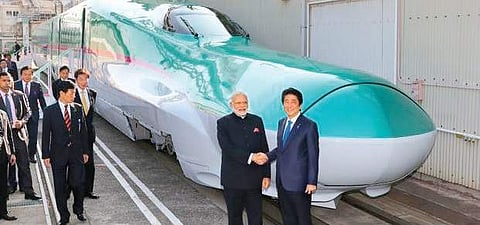

A leader lives on relationship; a nation thrives on economic and strategic ties. If the two disappear, there will always be a North Korea. For India, Japan is the trusted comrade against the ever-changing security architecture in the Asian region. Ties are measured through events. The announcement of the bullet train in India and the unprecedented investment of $4.7 billion by Japan in 2016-17 and advancing cooperation in various fields are not merely about finances and infrastructure.
The two countries covered a long and tumultuous journey in the last three decades, starting with only 108 Indo-Japanese ventures with only $12.6 million in investment. Now, scratch the relationship a little and one may find the real picture emerging—a samurai sword concealed in economic agreements—in Asia threatened by rogue nations like North Korea and Pakistan that enjoy tacit support from China.
North Korea has threatened to sink Japanese islands with its nuclear arsenals, and the Chinese reaction has been mild. As Indian and Japanese sides were finalising the deals on Thursday, 5,000 km away Pyongyang fired a ballistic missile the next day. It flew over Hokkaido, the northernmost island of Japan, before diving into the Pacific Ocean. Foreign Secretary S Jaishankar said there was a lot of discussion on North Korea, and the Japanese side underlined their concerns in strong terms. Prime Minister Narendra Modi and his Japanese counterpart Shinzo Abe condemned North Korea’s continued development of nuclear weapons and ballistic missile programmes.
Another important dimension of relationship is strengthening India’s role in the Indo-Pacific region. Japan is the heart of India’s core Asian policy and the fulcrum of the ‘look east’ initiative. India has wholeheartedly accepted the Japanese investment in Assam, Manipur, Nagaland and other states. The move will also be crucial for neighbours surrounding the landlocked region. The carefully-worded joint statement “align Japan’s free and open Indo-pacific strategy with India’s act east policy” says it all.
The Japanese offer to assist India in making roads and bridges in the Northeast will also help to checkmate Chinese infrastructure build-up on the border. India and Japan have taken a serious step towards deepening defence relationships, and several joint ventures are in the offing. These agreements will also give a boost to the India-Myanmar-Thailand Trilateral project, a much-needed road connectivity with Southeast Asia at a time when China is almost ready with $5.4 billion Thailand-China rail project.
The growing relationship that seeks to play a larger role in the new global order has been more or less organic. The US has been shouting from White House tops that the power equation in Asia needs to be changed. This was underlined by Modi-Abe when they talked about renewed momentum for trilateral cooperation with the US and Australia and shared willingness for concrete cooperation. This bold step was first taken with former Prime Minister Rajiv Gandhi making a short, though significant, visit to Tokyo in October 1987. Within a few hours, then Japanese Prime Minister Nakasone had offered India a $200 million long-term, low-term interest loan. It was just the beginning. Soon, Japan had replaced then Soviet Union as India’s second leading commercial partner after the US. The CIA had asserted in 1987 that Japan was likely to become India’s largest commercial partner in a few years.
The two countries have come a long way when New Delhi was wary that Tokyo was primarily interested in making quick bucks by selling Made in Japan goods instead of serious ventures. Modi-Abe heads and hearts focusing on a greater Asia is a bold and firm signal to break the shell of the past.